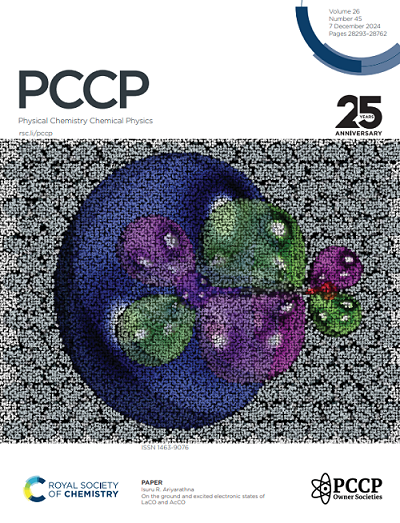Linear–Cyclic Isomer Competition in Protonated Ethanol–Methanol Clusters Probed by Infrared Spectroscopy and Deep Learning Structural and Dynamical Simulations
IF 2.9
3区 化学
Q3 CHEMISTRY, PHYSICAL
引用次数: 0
Abstract
The competition between linear and cyclic isomer structures in the protonated ethanol tetramer has been investigated using spectroscopic and theoretical approaches. Infrared spectroscopy of protonated ethanol–methanol mixed tetramers, cooled by the inert gas tagging technique, revealed a significant dependence of the isomer structure competition on the mixing ratio and the tag species. To investigate isomer competition, structure searches were performed using the parallelized Basin-Hopping algorithm with neural network potentials that approximate the accuracy of density functional theory. Spectral simulations were conducted via harmonic vibrational analysis of key stable isomers using density functional theory and power spectral density calculations from molecular dynamics trajectories based on the neural network potentials. Comparison with experimental data reveals that the global minimum of the protonated ethanol tetramer is a linear structure. Additionally, the tag species significantly influences the relative stability of linear and cyclic isomers, as well as the isomerization barrier between these two structures.基于红外光谱和深度学习结构与动力学模拟的质子化乙醇-甲醇团簇线性环异构体竞争研究
用光谱和理论方法研究了质子化乙醇四聚体中线性和环状异构体结构之间的竞争。用惰性气体标记技术冷却的质子化乙醇-甲醇混合四聚体的红外光谱结果表明,异构体结构竞争对混合比例和标记物质有显著的依赖性。为了研究同分异构体的竞争,我们使用了具有近似密度泛函理论精度的神经网络电位的并行盆地跳跃算法进行结构搜索。利用密度泛函理论对关键稳定异构体进行了谐波振动分析,并基于神经网络电位计算了分子动力学轨迹的功率谱密度。与实验数据的比较表明,质子化乙醇四聚体的全局最小值为线性结构。此外,标签种类显著影响线性和环状异构体的相对稳定性,以及这两种结构之间的异构化屏障。
本文章由计算机程序翻译,如有差异,请以英文原文为准。
求助全文
约1分钟内获得全文
求助全文
来源期刊

Physical Chemistry Chemical Physics
化学-物理:原子、分子和化学物理
CiteScore
5.50
自引率
9.10%
发文量
2675
审稿时长
2.0 months
期刊介绍:
Physical Chemistry Chemical Physics (PCCP) is an international journal co-owned by 19 physical chemistry and physics societies from around the world. This journal publishes original, cutting-edge research in physical chemistry, chemical physics and biophysical chemistry. To be suitable for publication in PCCP, articles must include significant innovation and/or insight into physical chemistry; this is the most important criterion that reviewers and Editors will judge against when evaluating submissions.
The journal has a broad scope and welcomes contributions spanning experiment, theory, computation and data science. Topical coverage includes spectroscopy, dynamics, kinetics, statistical mechanics, thermodynamics, electrochemistry, catalysis, surface science, quantum mechanics, quantum computing and machine learning. Interdisciplinary research areas such as polymers and soft matter, materials, nanoscience, energy, surfaces/interfaces, and biophysical chemistry are welcomed if they demonstrate significant innovation and/or insight into physical chemistry. Joined experimental/theoretical studies are particularly appreciated when complementary and based on up-to-date approaches.
 求助内容:
求助内容: 应助结果提醒方式:
应助结果提醒方式:


